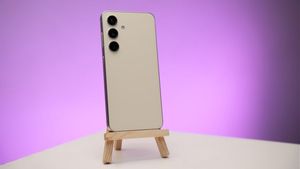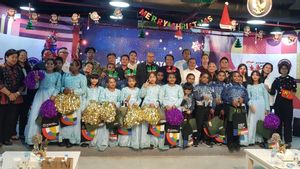JAKARTA - Social media was shocked by a number of photos of singer Justin Bieber wearing a red-and-white keffiyeh which is a symbol of the pro-Palestinian struggle. He wore a keffiyeh on his head and combined it with a gray hoodie.
In the photo, Justin Bieber is in a Tesla Cybertruck to leave Chateau Marmont in Los Angeles. Photo of Hailey Bieber's husband wearing a keffiyeh has gone viral on social media.
Palestinians are known to have the characteristics that they like to use keffiyeh. Reporting from the Kuvrd page, Keffiyeh, which is also known as 'kufiya','shemagh', or 'hatta' is a square-shaped cotton scarf. However, we all know that this scarf is more than just that.
Keffiyeh has a long and complicated history. The roots came from Mesopotamia in 3100 BC, worn by the Babylonian and Sumerian nations. The word keffiyeh actually comes from the Kufa area of Iraq and means 'from the city of Kufa'.
Syal, which is usually made of cotton, is an important outfit for the Bedouin in the desert and the Fellahi tribe, which uses it as a protection against heat and sandstorms. Now, this scarf has many names and can be found in many Arab countries such as Palestine, Jordan, Saudi Arabia, United Arab Emirates, and Iraq.
SEE ALSO:
The color, style, and symbolic meaning of keffiyeh depend on the country, as red and white are usually associated with Jordan, while in Palestine, black and white scarfs are primarily worn for the purpose of resistance and solidarity.
In addition, keffiyeh has long been identified as a symbol of the Palestinian people's resistance to occupation and injustice. During the Intifada (Palestinian insurgency) in the late 1980s, the ffiyeh was imposed by Palestinian fighters and activists as a sign of solidarity and resistance against Israeli occupation.
This was also reinforced by Yasser Arafat, the leader of the Palestinian Liberation Organization, because he always wore a scarf on his head during the fight against the occupation.
In the classical Palestinian keffiyeh, there are three main patterns displayed, including a net-like pattern resembling a small interconnected diamond shape.
This pattern is often interpreted as a symbol of the relationship between the Palestinian people and their soil, reflecting strong networks between individuals and communities.
Then there is also a woven pattern. On the edge of keffiyeh, there are usually shaded ropes which are also an important part of the traditional design. This woven rope adds character and texture, as well as strengthens the authentic and traditional impressions of keffiyeh.
In addition, there is a classic keffiyeh pattern including symbols of date palm trees, wheat or olive leaves that symbolize the fertility of Palestinian soil to the survival of the Palestinian people.
The English, Chinese, Japanese, Arabic, and French versions are automatically generated by the AI. So there may still be inaccuracies in translating, please always see Indonesian as our main language. (system supported by DigitalSiber.id)
















